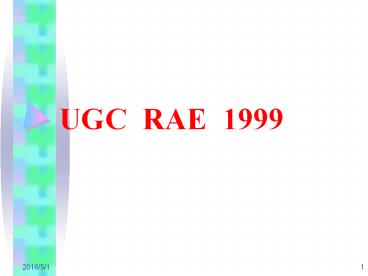UGC RAE 1999
1 / 33
Title: UGC RAE 1999
1
UGC RAE 1999
2
Guidance Notes
- 22 Jan 1999
- on UGC Web
3
History
- RAE1 1993
- RAE2 1996
- RAE3 1999
4
Immediate purpose
- Funding T R
- But R is not everything !
- Public accountability
- Induce improvements
5
Principles
- Assess CC
- Aggregate individuals
- Based on output
- Threshold measurement
6
New features
- 1. Broaden research
- 2. Emphasize not assessing individuals
- 3. Look for coherence
- institution
- CC
- individual
7
1. Broaden definition
- Discovery
- Integration
- Application
- Teaching
- Carnegie Foundation Scholarship Reconsidered
(1990)
8
Discovery
- The scholarship of discovery, at its best,
contributes not only to the stock of human
knowledge but also to the intellectual climate of
an institution. It is a scholarly investigation,
closest to what is meant when academics speak of
"research", that confronts the unknown and
creates new knowledge.
9
Discovery (contd)
- Not just the outcomes, but the process, and
especially the passion, give meaning to the
effort.
10
Integration
- It is a serious, disciplined work that seeks to
interpret, draw together and bring new insight to
bear on original research. The scholarship is
closely related to discovery. Such work is
increasingly important as traditional
disciplinary categories prove confining, forcing
new topologies of knowledge.
11
Integration (contd)
- This scholarship also means interpretation,
fitting one's own research -- or the research of
others -- into larger intellectual patterns. A
variety of scholarly trends -- interdisciplinary,
interpretive, integrative, are examples of
scholarship of integration.
12
Application
- It is a dynamic process of creating new
intellectual understandings arising out of theory
and practice. The term itself may be misleading
if it suggests that knowledge is first
"discovered" and then "applied". The process is
in fact more dynamic new intellectual
understanding can arise out of vital interaction
between theory and practice, and one renews the
other.
13
Teaching
- It is a process that transforms and extends
knowledge while transmitting an intelligible
account of knowledge to the learners.
14
Distribution
- Expect distribution of submissions to be
reasonable given - nature of subject
- role and mission ( strategy statement)
- Scoring will be without regard to distribution
15
Research index
- p 100 x A / T
- T number of academic staff in a cost centre
(who meet certain criteria) in fte - A the number among these judged to have
reached or surpassed the quality threshold,
including fractional counts
16
2. De-emphasize individual
- Will not use active researcher (AR)
- of AR ? research index
- Individual results will not be
- kept
- released
- used
- More a matter of adopting less misleading
nomneclature
17
3. Look for coherence
- Institution --- strategy statement
- CC --- Table 1
- Individual submissions --- Table 3
18
Number who reach quality threshold
- 1. Submit
- 2. Assess
19
1. Submit
- Period of assessment
- What to submit
- Definition of output
- Number of items
- Co-authors
20
Period of assessment
- 4 years
- 1 Jan 95 --- 31 Dec 98
21
What to submit
- up to 5 best research output items within the
period of assessment, - if considered appropriate, one exceptional
research output item outside assessment period.
22
Output
- innovation AND
- contribute to scholarship AND
- publicly accessible AND
- of interest to peers and generalizable.
- does not matter whether funded by the UGC
23
Specifically
- any publication, patent, artifact, etc.,
- published or made publicly available within the
assessment period or - not yet published, but officially accepted in
that period - other output e.g. drama, concert performance,
video tape, computer software, buildings,
creative work that can be evaluated
24
Number of items
- Quality, not quantity
- May submit fewer than 5
- Can meet threshold on the basis of even one
- In the majority of cases, a clear decision should
be able to be made on the basis of 3
25
Co-authors
- Individuals are proxies for the CC
- Need to form a view on the CC's involvement
- Not a multiplier if judged to have made
significant intellectual contribution, not
pro-rated or discounted
26
2. Assess
- Panels
- Quality threshold
27
Quality threshold
- Quality of output equates to an attainable level
of excellence appropriate to the discipline in
Hong Kong, and showing some evidence of
international excellence. - Then to give special recognition for societal
relevance, symbiosis with industry, commerce and
government, and/or with local culture and society.
28
Comparability
- Each panel to translate general definition into
more precise benchmarks - Strive for broad comparability across disciplines
29
- Attainable
- international excellence
- international vs local
30
Holistic view
- View submission as a whole,
- Not score each item individually, not n/5.
- Evaluate based on best 3
31
Quality
- Judged on own merits
- Not on venue / category / language
32
Results
- No individually identifiable scores
- Total score of CC to Head of the institution
concerned - sector-wide average and median (if not fewer
than three institutions)
33
Rectifying misconceptions
- "UGC requires every individual academic to
produce 5 international journal papers"































